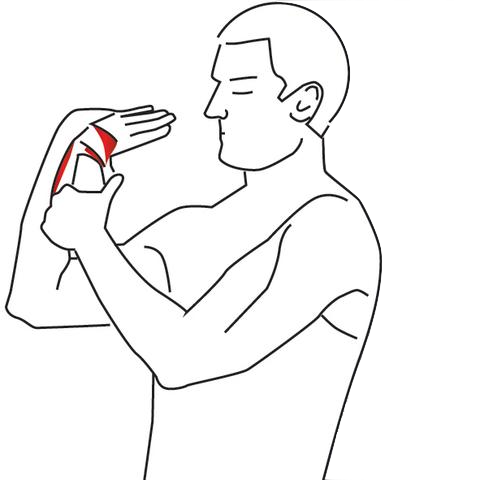Rehab and Injury Prevention for Wrist and Elbow Pain

Myofascial Trigger Points (MTPs) are ubiquitous, and myofascial pain affects as much as 85% of the population at some time in their life
The impact of myofascial pain on health can be severe as patients not only suffer from pain and loss of function, but also from impaired mood and decreased quality of life.
Elbow and wrist pain are common, and may often be associated with trigger points in the muscles of the upper arm, lower arm, and shoulder.
Stretching alone is unlikely to dissipate trigger points, but it may help accelerate the process as part of a broader treatment and certainly may provide some pain relief.
Here below and in the video above are some simple stretches that we typically use and recommend. Please take note of the instructions. Always start slowly, work within your limits, and use common sense!
As always, ask your therapist about trigger points :)
1

TECHNIQUE
While crouching on your knees with your forearms facing forward and hands pointing backwards, slowly move rearward.
Primary muscles: Biceps brachii. Brachialis. Brachioradialis. Coracobrachialis.
INJURY WHERE STRETCH MAY BE USEFUL
Biceps tendon rupture. Bicepital tendonitis. Biceps strain. Elbow strain. Elbow dislocation. Elbow bursitis. Tennis elbow. Golfer’s elbow. Thrower’s elbow.
ADDITIONAL INFORMATION FOR PERFORMING THIS STRETCH CORRECTLY
Depending on where your muscles are most tight, you may feel this stretch more in your forearms or more in your upper arms. To make this stretch easier, move your hands towards your knees.
2

TECHNIQUE
MUSCLES BEING STRETCHED
Primary muscles: Brachialis. Brachioradialis. Pronator teres. Flexor carpi radialis. Flexor carpi ulnaris. Palmaris longus.
Secondary muscles: Flexor digitorum superficialis. Flexor digitorum profundus. Flexor pollicis longus.
Tennis elbow. Golfer’s elbow. Thrower’s elbow. Wrist sprain. Wrist dislocation. Wrist tendonitis. Carpal tunnel syndrome. Ulnar tunnel syndrome.
ADDITIONAL INFORMATION FOR PERFORMING THIS STRETCH CORRECTLY
The forearms, wrists, and fingers comprise a multitude of small muscles, tendons, and ligaments. Do not overstretch this area by applying too much force too quickly.
3

TECHNIQUE
Place one arm straight out in front and parallel to the ground. Rotate your wrist down and outwards and then use your other hand to further rotate your hand upwards.
MUSCLES BEING STRETCHED
Primary muscles: Brachioradialis. Extensor carpi ulnaris. Supinator.
Secondary muscles: Extensor digitorum. Extensor pollicis longus and brevis.
INJURY WHERE STRETCH MAY BE USEFUL
Tennis elbow. Golfer’s elbow. Thrower’s elbow. Wrist sprain. Wrist dislocation. Wrist tendonitis. Carpal tunnel syndrome. Ulnar tunnel syndrome.
ADDITIONAL INFORMATION FOR PERFORMING THIS STRETCH CORRECTLY
The forearms, wrists, and fingers comprise a multitude of small muscles, tendons, and ligaments. Do not overstretch this area by applying too much force too quickly.
4

TECHNIQUE
Hold on to your fingers while straightening your arm. Pull your fingers towards your body.
MUSCLES BEING STRETCHED
Primary muscles: Extensor carpi ulnaris. Extensor carpi radialis longus and brevis. Extensor digitorum.
Secondary muscles: Extensor digiti minimi. Extensor indicis.
INJURY WHERE STRETCH MAY BE USEFUL
Tennis elbow. Golfer’s elbow. Thrower’s elbow. Wrist sprain. Wrist dislocation. Wrist tendonitis. Carpal tunnel syndrome. Ulnar tunnel syndrome.
ADDITIONAL INFORMATION FOR PERFORMING THIS STRETCH CORRECTLY
The forearms, wrists, and fingers comprise a multitude of small muscles, tendons, and ligaments. Do not overstretch this area by applying too much force too quickly.
5

TECHNIQUE
Start with your fingers pointing up and your thumb out to one side, then use your other hand to pull your thumb down.
MUSCLES BEING STRETCHED
Primary muscles: Flexor pollicis longus. Flexor pollicis brevis.
Secondary muscles: Adductor pollicis. Opponens pollicis.
INJURY WHERE STRETCH MAY BE USEFUL
Tennis elbow. Golfer’s elbow. Thrower’s elbow. Wrist sprain. Wrist dislocation. Wrist tendonitis. Carpal tunnel syndrome. Ulnar tunnel syndrome.
ADDITIONAL INFORMATION FOR PERFORMING THIS STRETCH CORRECTLY
The palm and thumb comprise a multitude of small muscles, tendons, and ligaments. Do not overstretch this area by applying too much force too quickly.
Links
More Articles About Elbow Pain
Dry Needling for Trigger Points
Certify as a Trigger Point Therapist
Related videos from our Youtube channel:
Wrist Flexors - Trigger Point Release
Wrist Extensors - Trigger Point Release
Carpal Tunnel Syndrome Explained
This blog is intended to be used for information purposes only and is not intended to be used for medical diagnosis or treatment or to substitute for a medical diagnosis and/or treatment rendered or prescribed by a physician or competent healthcare professional. This information is designed as educational material, but should not be taken as a recommendation for treatment of any particular person or patient. Always consult your physician if you think you need treatment or if you feel unwell.

Learn More for Less

Unlimited access to all CE courses for just $19.95/mo







